Yu Zhong
Heartcare Suite: Multi-dimensional Understanding of ECG with Raw Multi-lead Signal Modeling
Jun 06, 2025Abstract:We present Heartcare Suite, a multimodal comprehensive framework for finegrained electrocardiogram (ECG) understanding. It comprises three key components: (i) Heartcare-220K, a high-quality, structured, and comprehensive multimodal ECG dataset covering essential tasks such as disease diagnosis, waveform morphology analysis, and rhythm interpretation. (ii) Heartcare-Bench, a systematic and multi-dimensional benchmark designed to evaluate diagnostic intelligence and guide the optimization of Medical Multimodal Large Language Models (Med-MLLMs) in ECG scenarios. and (iii) HeartcareGPT with a tailored tokenizer Bidirectional ECG Abstract Tokenization (Beat), which compresses raw multi-lead signals into semantically rich discrete tokens via duallevel vector quantization and query-guided bidirectional diffusion mechanism. Built upon Heartcare-220K, HeartcareGPT achieves strong generalization and SoTA performance across multiple clinically meaningful tasks. Extensive experiments demonstrate that Heartcare Suite is highly effective in advancing ECGspecific multimodal understanding and evaluation. Our project is available at https://github.com/Wznnnnn/Heartcare-Suite .
Taming Flow Matching with Unbalanced Optimal Transport into Fast Pansharpening
Mar 19, 2025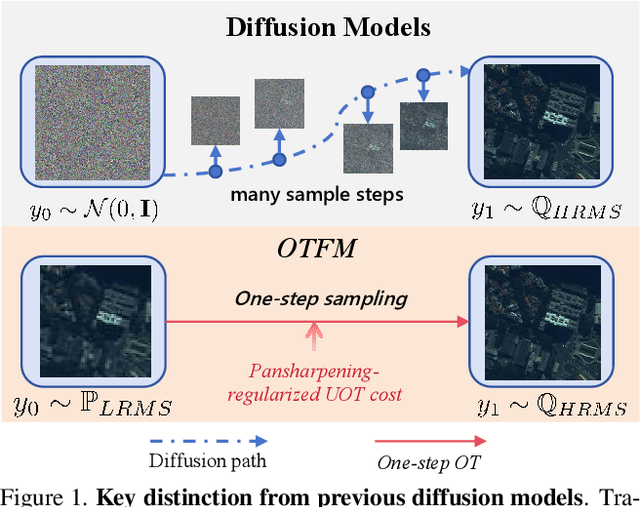
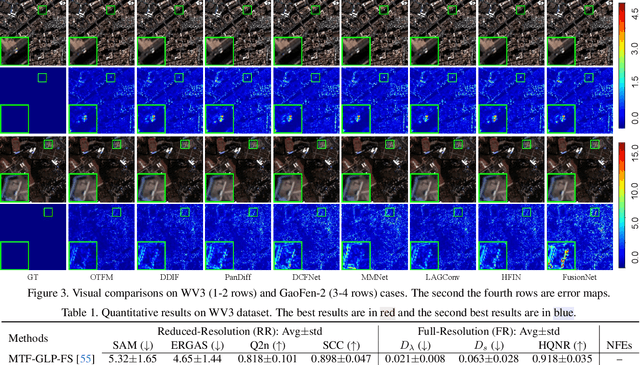
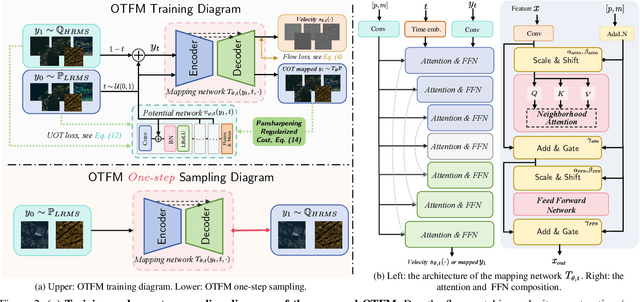
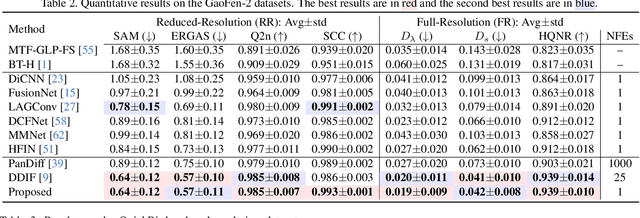
Abstract:Pansharpening, a pivotal task in remote sensing for fusing high-resolution panchromatic and multispectral imagery, has garnered significant research interest. Recent advancements employing diffusion models based on stochastic differential equations (SDEs) have demonstrated state-of-the-art performance. However, the inherent multi-step sampling process of SDEs imposes substantial computational overhead, hindering practical deployment. While existing methods adopt efficient samplers, knowledge distillation, or retraining to reduce sampling steps (e.g., from 1,000 to fewer steps), such approaches often compromise fusion quality. In this work, we propose the Optimal Transport Flow Matching (OTFM) framework, which integrates the dual formulation of unbalanced optimal transport (UOT) to achieve one-step, high-quality pansharpening. Unlike conventional OT formulations that enforce rigid distribution alignment, UOT relaxes marginal constraints to enhance modeling flexibility, accommodating the intrinsic spectral and spatial disparities in remote sensing data. Furthermore, we incorporate task-specific regularization into the UOT objective, enhancing the robustness of the flow model. The OTFM framework enables simulation-free training and single-step inference while maintaining strict adherence to pansharpening constraints. Experimental evaluations across multiple datasets demonstrate that OTFM matches or exceeds the performance of previous regression-based models and leading diffusion-based methods while only needing one sampling step. Codes are available at https://github.com/294coder/PAN-OTFM.
MMAIF: Multi-task and Multi-degradation All-in-One for Image Fusion with Language Guidance
Mar 19, 2025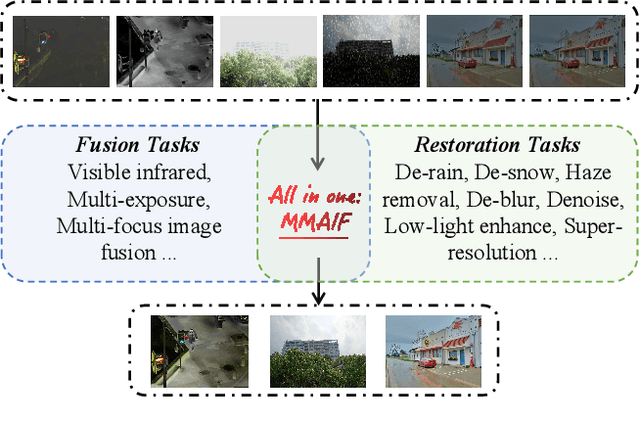


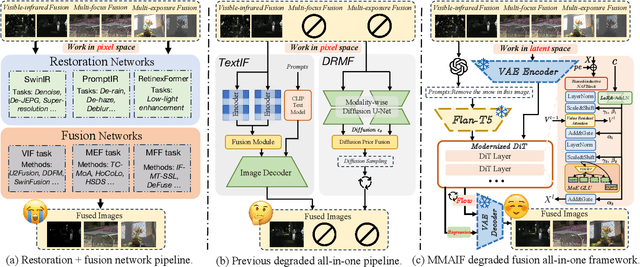
Abstract:Image fusion, a fundamental low-level vision task, aims to integrate multiple image sequences into a single output while preserving as much information as possible from the input. However, existing methods face several significant limitations: 1) requiring task- or dataset-specific models; 2) neglecting real-world image degradations (\textit{e.g.}, noise), which causes failure when processing degraded inputs; 3) operating in pixel space, where attention mechanisms are computationally expensive; and 4) lacking user interaction capabilities. To address these challenges, we propose a unified framework for multi-task, multi-degradation, and language-guided image fusion. Our framework includes two key components: 1) a practical degradation pipeline that simulates real-world image degradations and generates interactive prompts to guide the model; 2) an all-in-one Diffusion Transformer (DiT) operating in latent space, which fuses a clean image conditioned on both the degraded inputs and the generated prompts. Furthermore, we introduce principled modifications to the original DiT architecture to better suit the fusion task. Based on this framework, we develop two versions of the model: Regression-based and Flow Matching-based variants. Extensive qualitative and quantitative experiments demonstrate that our approach effectively addresses the aforementioned limitations and outperforms previous restoration+fusion and all-in-one pipelines. Codes are available at https://github.com/294coder/MMAIF.
MAKIMA: Tuning-free Multi-Attribute Open-domain Video Editing via Mask-Guided Attention Modulation
Dec 28, 2024



Abstract:Diffusion-based text-to-image (T2I) models have demonstrated remarkable results in global video editing tasks. However, their focus is primarily on global video modifications, and achieving desired attribute-specific changes remains a challenging task, specifically in multi-attribute editing (MAE) in video. Contemporary video editing approaches either require extensive fine-tuning or rely on additional networks (such as ControlNet) for modeling multi-object appearances, yet they remain in their infancy, offering only coarse-grained MAE solutions. In this paper, we present MAKIMA, a tuning-free MAE framework built upon pretrained T2I models for open-domain video editing. Our approach preserves video structure and appearance information by incorporating attention maps and features from the inversion process during denoising. To facilitate precise editing of multiple attributes, we introduce mask-guided attention modulation, enhancing correlations between spatially corresponding tokens and suppressing cross-attribute interference in both self-attention and cross-attention layers. To balance video frame generation quality and efficiency, we implement consistent feature propagation, which generates frame sequences by editing keyframes and propagating their features throughout the sequence. Extensive experiments demonstrate that MAKIMA outperforms existing baselines in open-domain multi-attribute video editing tasks, achieving superior results in both editing accuracy and temporal consistency while maintaining computational efficiency.
A Decade of Deep Learning: A Survey on The Magnificent Seven
Dec 13, 2024Abstract:Deep learning has fundamentally reshaped the landscape of artificial intelligence over the past decade, enabling remarkable achievements across diverse domains. At the heart of these developments lie multi-layered neural network architectures that excel at automatic feature extraction, leading to significant improvements in machine learning tasks. To demystify these advances and offer accessible guidance, we present a comprehensive overview of the most influential deep learning algorithms selected through a broad-based survey of the field. Our discussion centers on pivotal architectures, including Residual Networks, Transformers, Generative Adversarial Networks, Variational Autoencoders, Graph Neural Networks, Contrastive Language-Image Pre-training, and Diffusion models. We detail their historical context, highlight their mathematical foundations and algorithmic principles, and examine subsequent variants, extensions, and practical considerations such as training methodologies, normalization techniques, and learning rate schedules. Beyond historical and technical insights, we also address their applications, challenges, and potential research directions. This survey aims to serve as a practical manual for both newcomers seeking an entry point into cutting-edge deep learning methods and experienced researchers transitioning into this rapidly evolving domain.
World-Consistent Data Generation for Vision-and-Language Navigation
Dec 09, 2024Abstract:Vision-and-Language Navigation (VLN) is a challenging task that requires an agent to navigate through photorealistic environments following natural-language instructions. One main obstacle existing in VLN is data scarcity, leading to poor generalization performance over unseen environments. Tough data argumentation is a promising way for scaling up the dataset, how to generate VLN data both diverse and world-consistent remains problematic. To cope with this issue, we propose the world-consistent data generation (WCGEN), an efficacious data-augmentation framework satisfying both diversity and world-consistency, targeting at enhancing the generalizations of agents to novel environments. Roughly, our framework consists of two stages, the trajectory stage which leverages a point-cloud based technique to ensure spatial coherency among viewpoints, and the viewpoint stage which adopts a novel angle synthesis method to guarantee spatial and wraparound consistency within the entire observation. By accurately predicting viewpoint changes with 3D knowledge, our approach maintains the world-consistency during the generation procedure. Experiments on a wide range of datasets verify the effectiveness of our method, demonstrating that our data augmentation strategy enables agents to achieve new state-of-the-art results on all navigation tasks, and is capable of enhancing the VLN agents' generalization ability to unseen environments.
SSDiff: Spatial-spectral Integrated Diffusion Model for Remote Sensing Pansharpening
Apr 17, 2024



Abstract:Pansharpening is a significant image fusion technique that merges the spatial content and spectral characteristics of remote sensing images to generate high-resolution multispectral images. Recently, denoising diffusion probabilistic models have been gradually applied to visual tasks, enhancing controllable image generation through low-rank adaptation (LoRA). In this paper, we introduce a spatial-spectral integrated diffusion model for the remote sensing pansharpening task, called SSDiff, which considers the pansharpening process as the fusion process of spatial and spectral components from the perspective of subspace decomposition. Specifically, SSDiff utilizes spatial and spectral branches to learn spatial details and spectral features separately, then employs a designed alternating projection fusion module (APFM) to accomplish the fusion. Furthermore, we propose a frequency modulation inter-branch module (FMIM) to modulate the frequency distribution between branches. The two components of SSDiff can perform favorably against the APFM when utilizing a LoRA-like branch-wise alternative fine-tuning method. It refines SSDiff to capture component-discriminating features more sufficiently. Finally, extensive experiments on four commonly used datasets, i.e., WorldView-3, WorldView-2, GaoFen-2, and QuickBird, demonstrate the superiority of SSDiff both visually and quantitatively. The code will be made open source after possible acceptance.
A Novel State Space Model with Local Enhancement and State Sharing for Image Fusion
Apr 14, 2024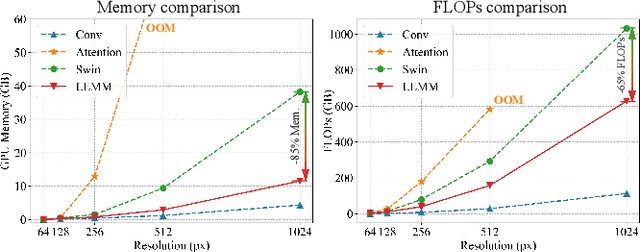
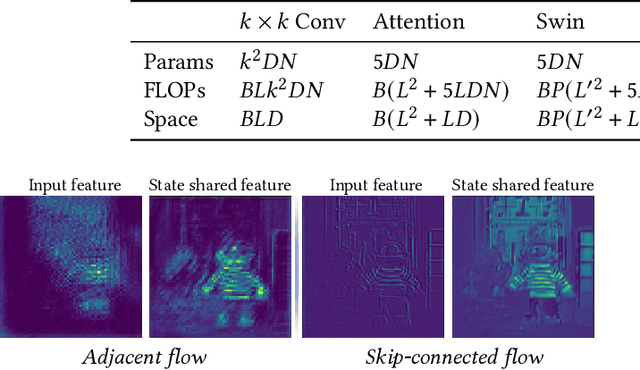
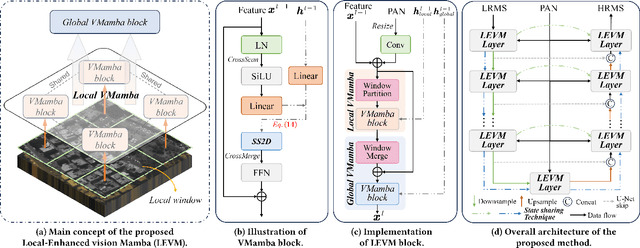
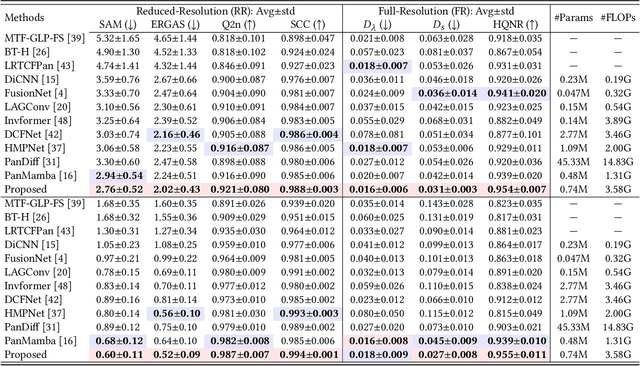
Abstract:In image fusion tasks, images from different sources possess distinct characteristics. This has driven the development of numerous methods to explore better ways of fusing them while preserving their respective characteristics. Mamba, as a state space model, has emerged in the field of natural language processing. Recently, many studies have attempted to extend Mamba to vision tasks. However, due to the nature of images different from casual language sequences, the limited state capacity of Mamba weakens its ability to model image information. Additionally, the sequence modeling ability of Mamba is only capable of spatial information and cannot effectively capture the rich spectral information in images. Motivated by these challenges, we customize and improve the vision Mamba network designed for the image fusion task. Specifically, we propose the local-enhanced vision Mamba block, dubbed as LEVM. The LEVM block can improve local information perception of the network and simultaneously learn local and global spatial information. Furthermore, we propose the state sharing technique to enhance spatial details and integrate spatial and spectral information. Finally, the overall network is a multi-scale structure based on vision Mamba, called LE-Mamba. Extensive experiments show the proposed methods achieve state-of-the-art results on multispectral pansharpening and multispectral and hyperspectral image fusion datasets, and demonstrate the effectiveness of the proposed approach. Code will be made available.
Point cloud-based registration and image fusion between cardiac SPECT MPI and CTA
Feb 10, 2024Abstract:A method was proposed for the point cloud-based registration and image fusion between cardiac single photon emission computed tomography (SPECT) myocardial perfusion images (MPI) and cardiac computed tomography angiograms (CTA). Firstly, the left ventricle (LV) epicardial regions (LVERs) in SPECT and CTA images were segmented by using different U-Net neural networks trained to generate the point clouds of the LV epicardial contours (LVECs). Secondly, according to the characteristics of cardiac anatomy, the special points of anterior and posterior interventricular grooves (APIGs) were manually marked in both SPECT and CTA image volumes. Thirdly, we developed an in-house program for coarsely registering the special points of APIGs to ensure a correct cardiac orientation alignment between SPECT and CTA images. Fourthly, we employed ICP, SICP or CPD algorithm to achieve a fine registration for the point clouds (together with the special points of APIGs) of the LV epicardial surfaces (LVERs) in SPECT and CTA images. Finally, the image fusion between SPECT and CTA was realized after the fine registration. The experimental results showed that the cardiac orientation was aligned well and the mean distance error of the optimal registration method (CPD with affine transform) was consistently less than 3 mm. The proposed method could effectively fuse the structures from cardiac CTA and SPECT functional images, and demonstrated a potential in assisting in accurate diagnosis of cardiac diseases by combining complementary advantages of the two imaging modalities.
Feature-based Transferable Disruption Prediction for future tokamaks using domain adaptation
Sep 11, 2023



Abstract:The high acquisition cost and the significant demand for disruptive discharges for data-driven disruption prediction models in future tokamaks pose an inherent contradiction in disruption prediction research. In this paper, we demonstrated a novel approach to predict disruption in a future tokamak only using a few discharges based on a domain adaptation algorithm called CORAL. It is the first attempt at applying domain adaptation in the disruption prediction task. In this paper, this disruption prediction approach aligns a few data from the future tokamak (target domain) and a large amount of data from the existing tokamak (source domain) to train a machine learning model in the existing tokamak. To simulate the existing and future tokamak case, we selected J-TEXT as the existing tokamak and EAST as the future tokamak. To simulate the lack of disruptive data in future tokamak, we only selected 100 non-disruptive discharges and 10 disruptive discharges from EAST as the target domain training data. We have improved CORAL to make it more suitable for the disruption prediction task, called supervised CORAL. Compared to the model trained by mixing data from the two tokamaks, the supervised CORAL model can enhance the disruption prediction performance for future tokamaks (AUC value from 0.764 to 0.890). Through interpretable analysis, we discovered that using the supervised CORAL enables the transformation of data distribution to be more similar to future tokamak. An assessment method for evaluating whether a model has learned a trend of similar features is designed based on SHAP analysis. It demonstrates that the supervised CORAL model exhibits more similarities to the model trained on large data sizes of EAST. FTDP provides a light, interpretable, and few-data-required way by aligning features to predict disruption using small data sizes from the future tokamak.
 Add to Chrome
Add to Chrome Add to Firefox
Add to Firefox Add to Edge
Add to Edge